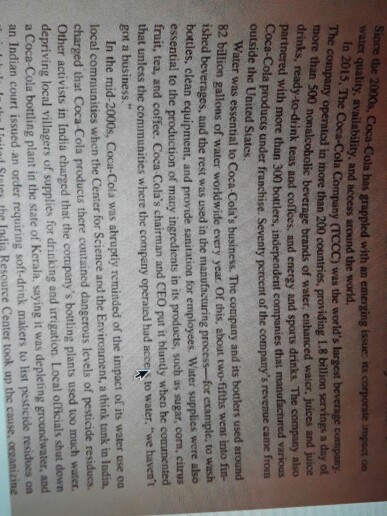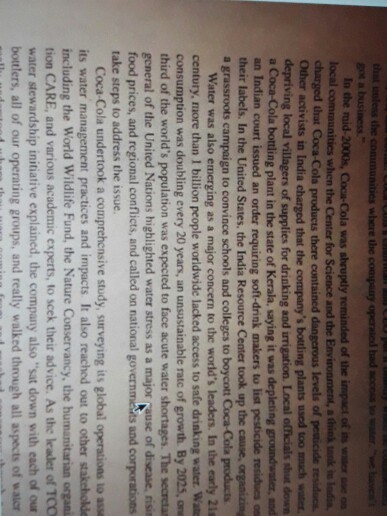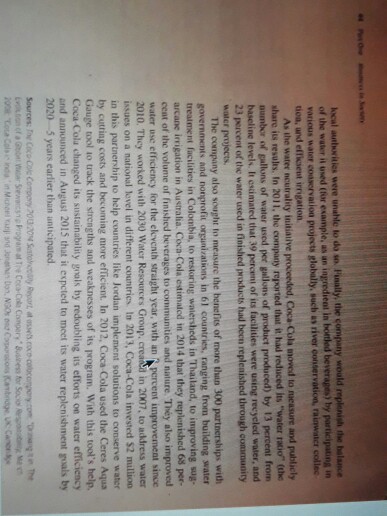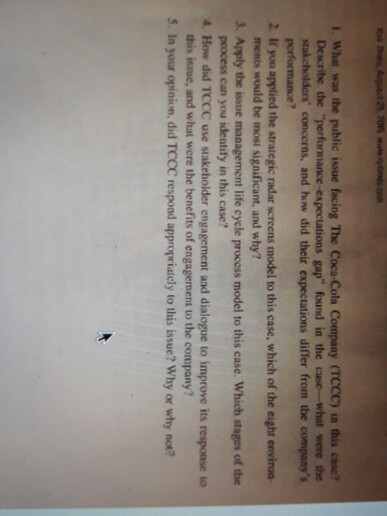Please answer all the questions with atleast 300 words each answer.
please do not give incomplete answers
don’t answer if cannot answer all the questions
In 2015, The more than 500 beverage brands of water, enhanced waicr. juices and juice outside the United States. under franchise. Seventy percent of the company’s revenue came from and its bottlers used around essential to the it, tea, and coffe. Coca Cola’s chairman and CEO pur it blany when he comented of many in its products, such as sugar, corn, citrus that unless the a business communities where the company operaied had acce to water. “we haven’t In the mid-2000s, Coca-Cola was abruptiy reminded of the impact of its water use ora communities when the Center for Science and the Environment, a think tank in lndia, charged that Coca Cola products there contained dangerous levels of pesticide residucs Other activists in India charged that the company’s botling plants used too much water. depriving local villagers of supplies for drinking and irrigation. Local officials shut down an Indian court issued an order requiring soft-drink makers to list pesticide residucs on
Expert Answer
1) The public issue in this case was over-utilization of the ground water resources in its production and bottling. TCCC is using tremendous amount of water in manufacturing the beverages which is leading to utilization of the ground water resources to a greater extent for the local communities.
There is certainly performance expectations gap in this case. The expectations of the local communities in saving the water is very high, but in reality, there is a huge gap in the performance initiaties that the company has started and the expectations that various stakeholders have on the organization. The “performance-expectation gap” defined in the book explains the gap between corporate performance versus stakeholder expectation. The stakeholders’ concerns particularly the state of Kerala in India stated that the TCCC was depleting groundwater and producing products that contained pesticide residues.
The stakeholders in this case are – TCCC, World Wildlife fund, Nature conservancy, The world business council for sustainable development, UNESCO, CARE, Local communities, Indian Government and Indian Resource center. The expectations of these stakeholders was to make sure that Coca-Cola carry out its services in an ethical manner by not depleting the natural resources and water of communities and serving harmful pesticides.
2) If we apply strategic radar screens model to this case, the most significant would be – Geophysical. Since TCCC has a negative impact on natural resources like water, when they are producing their beverages, by depleting and contaminating the ground water resources.
3) Stages that are identified in the case are:
- Identify the issue – TCCC realized their extensive use of water and the amount of the pesticides that are available in their products.
- Analyze the issue – TCCC conducted a comprehensive survey in assessing its water management practices and its impact on the global operations.
- Generate solutions – Have a discussion with the stakeholders, generate options and determine the best solution for the problem.
- Take action – Implement water neutrality goal and build web based tools in order to mitigate the given problem.
- Evaluate results – Determine the results based on the studies conducted, and based on the actions.
4) TCCC reached out to the stakeholders. It used stakeholder engagement and dialogue by successfully conducting meetings with the stakeholders in order to determine the best way of solving the problem, and the crisis that the company and the world is going through.
5) Initially they were very negative with the accusations that were made by India. But subsequently, they came in terms with the situation and responded appropriately by following the issue management process and partaking in the stakeholder engagement to resolve the issue.






